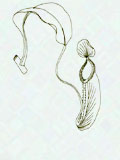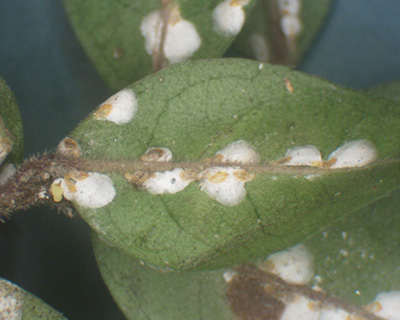

 |
 |
Invertebrates
| Scale insects on wild fruits | |
| Where are Hong Kong's forest ants? | |
| A deep dark discovery |
Scale insects on wild fruits
On the morning of the 15th December, at the peak of the fruiting season, I was walking up Hatton Road. Half way up, I was fascinated by clusters of downy holly (Ilex pubescens) hanging from the slope. Unfortunately, the whole plant was covered by some white scales that made it look scary. The scales looked just like flecks of white paint on the fruits! On closer examination, the scale insect was pear-shaped, about 2-3 mm long, and covered both sides of the leaves and fruits. It was identified as the Cockerell Scale Pseudaulacaspis cockerelli Cooley (Homoptera: Coccoidea: Diaspididae) by Mr. Clive Lau (Senior Agricultural Officer, AFCD). The fruits were also infected by a fungus. Under the microscope, this microfungus has a very long stalk, which expands slightly in the middle part and tapers at the apex. It was identified as Conidioxyphium sp. (Coelomycete). A few days later, I also noticed the same kind of scale insect on fruits of Psychotria asiatica and Ilex cinerea.
The Cockerell Scale is believed to have originated from Asia, and was first described in 1897 from California quarantine specimens from China. Established infestations were later found in Florida and Georgia (Reinert, 1974). It is known to infest over 100 plant species, including Magnolia grandiflora, M. virginiana, Aucuba japonica, Strelitzia spp., Hedera helix, Cornus florida, Taxus spp., Nerium oleander, Michelia figo, Elaeagus spp., Sabal mexicana, and Mangifera indica (Merrill, 1953; Johnson & Lyon, 1991; Crane & Campbell, 1994).
The Cockerell Scale is very difficult to control because it is dispersed rapidly by various means, including people, mammals, birds, ants and wind currents. It feeds on plant and fruit juices and also opens the way to infection by fungi. Depending on the severity of the infestation, the plant may lose its vigour, spots may appear due to toxins in the scale saliva, and deformation, leaf loss, and even death of the plant may occur (Beardsley & Gonzalez, 1975). Such damage can be significant to the plants in the wild and at the same time affects the possibility of seed dispersal because of the later fungal infection of the fruits.
 |
|
 |
|
| Scale insect Pseudaulacaspis cockerelli. (a) on Ilex pubescens fruits. (b) on Ilex pubescens leaf. |
Bibliography
Beardsley, J.W.Jr. & Gonzalez, R.H. (1975). The biology and ecology of armored scales. Annual Review of Entomology 20: 47-73.
Crane, J.H. & Campbell, C.W. (1994). The mango. UF/IFAS Fact Sheet HS-2.
Johnson, W.T. & Lyon, H.H. (1991). Insects that feed on trees and shrubs. 2nd ed., rev. Comstock Publishing Associates.
Merrill, G.B. (1953). A revision of the scale insects of Florida. Plant Board of Florida. Bull. 1: 1-143.
Reinert, J.A. (1974). Management of the false oleander scale. Pseudaulacaspis cockerelli (Cooley). Proc. Fla. State Hortic. Soc. 87: 518-520.
|
|
P.6 |
|
Porcupine! |
 Copyright © 2000 |